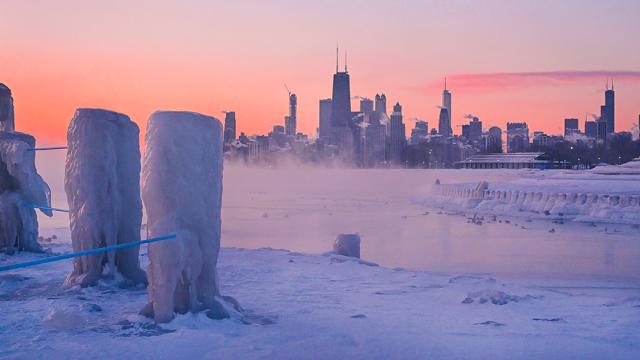
A mist rises over Lake Michigan as Chicago endures the recent Polar Vortex. Despite the spate of bitter cold over much of the country, this is shaping up to be a relatively normal winter. (Source: Shutterstock)
Higher demand from the power generation sector and low inventory heading into winter have created a volatile U.S. natural gas price market, Drillinginfo said in its “Natural Gas Winter Update,” released last week.
But strong fundamentals, including an uptick in production, may have painted a bigger picture in which the recent arctic snap across much of the country is little more than the storm before the calm.
“While production in the Northeast and Permian continues to grow, storage levels entered the winter at record lows,” said Rob McBride, Drillinginfo’s senior director of market intelligence, in a statement accompanying release of the report. “Early cold led to extreme price volatility which has since subsided as storage levels and weather returned closer to normal.”
Statistically, this winter has been nothing special, the report said, based on the 10-year average demand for gas. That means that Drillinginfo expects demand to average 101.7 billion cubic feet per day (Bcf/d) at season’s end. By contrast, the average during the most recent Polar Vortex winter of 2013-2014 was 106.6 Bcf/d. In a mild winter, like 2011-2012, the average would be expected at 96.7 Bcf/d.
Wood Mackenzie agreed with the assessment in its “Performance review: nuclear, fossil fuels, and renewables during the 2019 Polar Vortex” report. The 2014 Polar Vortex extended further south and lasted for several days, while the recent event eased up quickly. By contrast, last week’s gas withdrawal totaled 237 Bcf, compared to 288 Bcf in 2014 and well short of the record 359 Bcf experienced during the January 2018 “bomb cyclone.”
Concerns about low gas storage were eased by the warm end to 2018 and as a result, “gas market volatility remained largely in check with muted basis compared to 2014,” Wood Mac said. “By extension, power prices also remained in check with few extensions.”
Drillinginfo predicted natural gas storage will end the withdrawal season at a 1.36 trillion cubic feet (Tcf), with gas prices averaging $3.50 per million British thermal units (MMBtu). The U.S. Energy Information Administration reported that storage for the week ending Feb. 1 was 1.96 Tcf. The Henry Hub benchmark price on the afternoon of Feb. 8 was about $2.60/MMBtu; the average price in January was $3.10/MMBtu.
Production is anticipated to be up 7.275 Bcf/d this winter over winter 2017-2018, Drillinginfo said, with output from the Permian Basin, Marcellus and Utica shales providing 76% of the uplift. Even so, conversion of many coal-fired power generation plants to natural gas has strengthened demand, resulting in historically low gas inventories heading into winter. That, Drillinginfo said, made prices vulnerable to weather fluctuations.
Rising production is having a major impact on both the import market from Canada and export markets to Mexico by pipeline and global markets via LNG shipments.
Imports from Canada rose from 5.6 Bcf/d in 2017 to 5.8 Bcf/d in 2018, Drillinginfo said, but that trend is undergoing a shift. Midwest markets traditionally serviced by Canadian producers will receive gas from projects like the Rover and Nexus pipelines, which will move gas from Appalachia. Because of that, the analysts expect the Canadian import average to dip below 5 Bcf/d in 2019.
Pipelined exports to Mexico, which averaged less than 1 Bcf/d as recently as 2010, could reach 5 Bcf/d to 6 Bcf/d, assuming infrastructure on the Mexican side of the border is brought online.
U.S. LNG exports will rise about 26% to 4.3 Bcf/d in 2019, Drillinginfo said. By 2020, when more export facilities are online, that average could increase to 6.5 Bcf/d.
Recommended Reading
Well Logging Could Get a Makeover
2024-02-27 - Aramco’s KASHF robot, expected to deploy in 2025, will be able to operate in both vertical and horizontal segments of wellbores.
E&P Highlights: March 15, 2024
2024-03-15 - Here’s a roundup of the latest E&P headlines, including a new discovery and offshore contract awards.
Seadrill Awarded $97.5 Million in Drillship Contracts
2024-01-30 - Seadrill will also resume management services for its West Auriga drillship earlier than anticipated.
TotalEnergies Starts Production at Akpo West Offshore Nigeria
2024-02-07 - Subsea tieback expected to add 14,000 bbl/d of condensate by mid-year, and up to 4 MMcm/d of gas by 2028.
Shell Brings Deepwater Rydberg Subsea Tieback Onstream
2024-02-23 - The two-well Gulf of Mexico development will send 16,000 boe/d at peak rates to the Appomattox production semisubmersible.






